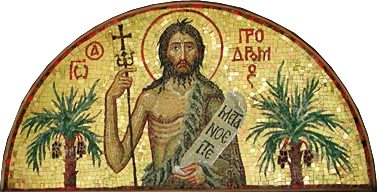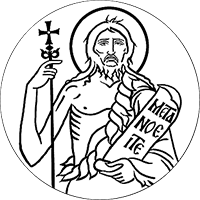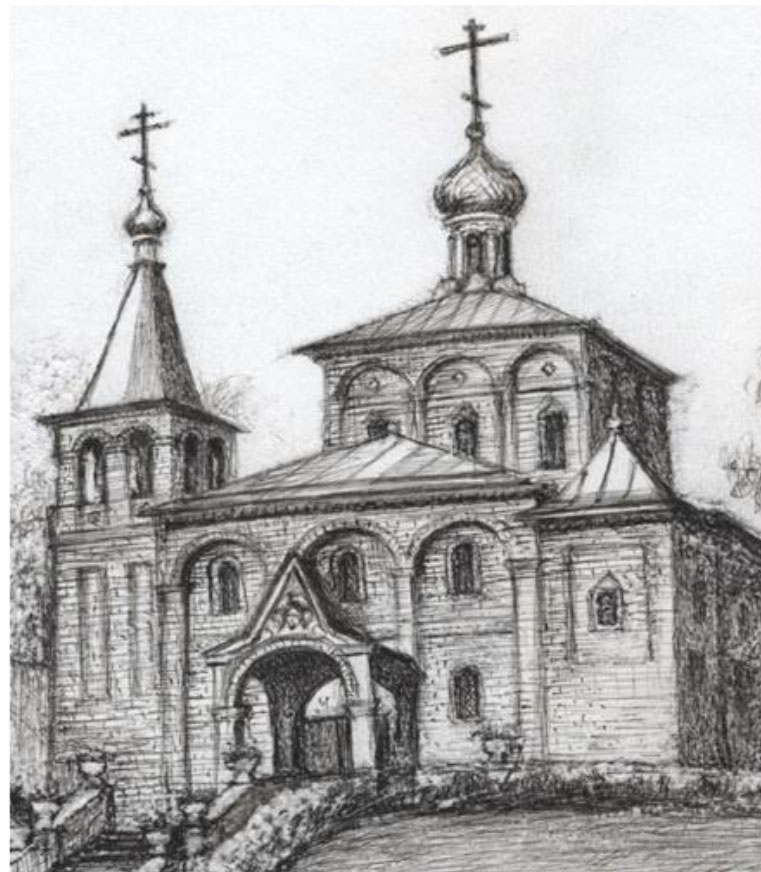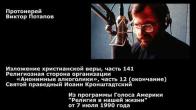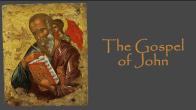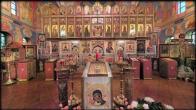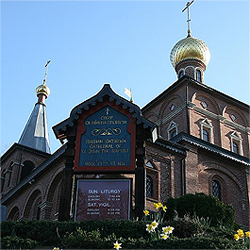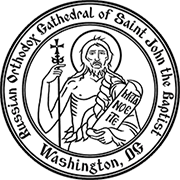You are here
December
- 19 November/2 December -- "Consolation in Grief and Sorrows"
- 21 November/4 December -- "The Entry of the Most Holy Theotokos into the Temple", in Serpukhov, Moscow Province
- 27 November/10 December -- "Of the Sign" Novgorod Icon, "Of the Sign" Pavlovsk Icon, "Of the Sign" - "Of Seraphimo-Ponetaev" Icon, "Kursk Root", "Sign" ("Korchemnaya" or "Tavern")
- 9/22 December -- "Unexpected Joy"
"Consolation in Grief and Sorrows"
19 November/ 2 December
The Icon of the Mother of God known as the “Consolation in Grief and Sorrows” Icon is a hinged icon dating to the 17th Century. According to tradition the Icon belonged to Patriarch Athanassy of Constantinople.
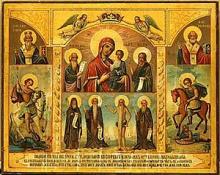 Athanassy spent his entire live doing battle in defense of Orthodoxy, against the Turks and the Jesuits. Out of obedience, several times he took on the Cross of serving as Patriarch of Constantinople. By the way, after being elected on the Feast of the Annunciation to the Most-holy Theotokos in 1634, he occupied the patriarchal throne for only 40 days, and in 1652, for one half of one month. After that, already third, departure, Vladyka Athanassy retired, living and working for Christ’s sake in Moldavia and Wallachia. In 1653 he went to Russia, where he was received in pomp by Tsar Alexei Michailovitch.
Athanassy spent his entire live doing battle in defense of Orthodoxy, against the Turks and the Jesuits. Out of obedience, several times he took on the Cross of serving as Patriarch of Constantinople. By the way, after being elected on the Feast of the Annunciation to the Most-holy Theotokos in 1634, he occupied the patriarchal throne for only 40 days, and in 1652, for one half of one month. After that, already third, departure, Vladyka Athanassy retired, living and working for Christ’s sake in Moldavia and Wallachia. In 1653 he went to Russia, where he was received in pomp by Tsar Alexei Michailovitch.
Throughout all of Vladyka’s travels and times of seclusion, including his time on Mt. Athos, he had the Consolation in Grief and Sorrows Icon with him. Hence, 1653 may be considered the year the Icon first came to Russia.
In 1654, Holy Hierarch Athanassy left Moscow for his homeland. In Lubno, Ukraine, he fell ill, and stopped to rest in the Holy Transfiguration Monastery in Mgarsk; there, he reposed on April 5, 1654. In keeping with the custom for burial of Eastern Patriarchs, he was buried in a sitting position. Eight years later, when his grave was opened, it was found that the Holy Hierarch’s body was incorrupt (“except that his right hand, which held his bishop’s staff, was missing two or three fingers.”). In 1662, Holy Hierarch Athanassy was glorified as a saint, and May 2/15 was set as the date of his commemoration.
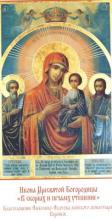 After Vladyka Athanassy’s death, the Consolation in Grief and Sorrows Icon was delivered to the Vatopedi Monastery on Mt. Athos, where it remained until October 1849, when the Russian Skete of St. Andrew came into being. Then Metropolitan Gregory, who was living in retirement at Vatopedi, gave the Icon to the newly-organized Skete as a blessing from the Monastery. The Icon remained in the cell of the founder, Fr. Vissarion. Before his death in 1862, he blessed the brethren with the Icon and said, “may this Icon be for you [a source of] exceeding joy and consolation in grief and sorrows.”
After Vladyka Athanassy’s death, the Consolation in Grief and Sorrows Icon was delivered to the Vatopedi Monastery on Mt. Athos, where it remained until October 1849, when the Russian Skete of St. Andrew came into being. Then Metropolitan Gregory, who was living in retirement at Vatopedi, gave the Icon to the newly-organized Skete as a blessing from the Monastery. The Icon remained in the cell of the founder, Fr. Vissarion. Before his death in 1862, he blessed the brethren with the Icon and said, “may this Icon be for you [a source of] exceeding joy and consolation in grief and sorrows.”
The Icon was glorified in Russia’s Vyatsk District in 1863, at the time that Hieromonk Paissy, bringing the Consolation in Grief and Sorrows Icon of the Mother of God from Mt. Athos, stopped to collect donations at Slobodskoy Village. It was then that the Theotokos deigned to glorify the icon through various miracles.
Now the Icon is in the St. Nicholas Cathedral in St. Petersburg. Evidence of the Icon’s miracle-working power also exists in contemporary Orthodox Russia. Thus, for example, in the St. Alexis-Akatov Convent in Voronezh, there is a copy of the Athonite Icon, bearing an inscription: “This icon was written and blessed on Holy Mt. Athos in the Russian Monastery of St. John Chrysostom, during the rectorship of Hieroschemamonk Kirill in 1905.” Shortly after some restoration work had been done on it in 1999, the Icon began to stream Myrrh. One day in July, streams of Myrrh poured from the eyes of the Most-holy Theotokos.
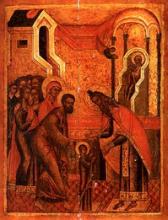 Before the Revolution of 1917, this image was in the diocesan women’s convent in Serpukhov. The following information regarding its origin has come down to us.
Ven. Varlaam, who lived in the 14th century and was a disciple of St. Alexis, Metropolitan of Moscow, once was granted a vision of an icon on which was depicted the Most Holy Virgin’s Entry into the Temple. Holy Hierarch St. Alexis then ordered that an icon like the one described in the vision of St. Varlaam be painted. The Icon was painted and installed in the stone church dedicated to the Entry of the Mother of God, in the Monastery of the Lord, founded in Serpukhov by St. Varlaam. Since 1377, when it was painted, it has been revered as miraculous.
Before the Revolution of 1917, this image was in the diocesan women’s convent in Serpukhov. The following information regarding its origin has come down to us.
Ven. Varlaam, who lived in the 14th century and was a disciple of St. Alexis, Metropolitan of Moscow, once was granted a vision of an icon on which was depicted the Most Holy Virgin’s Entry into the Temple. Holy Hierarch St. Alexis then ordered that an icon like the one described in the vision of St. Varlaam be painted. The Icon was painted and installed in the stone church dedicated to the Entry of the Mother of God, in the Monastery of the Lord, founded in Serpukhov by St. Varlaam. Since 1377, when it was painted, it has been revered as miraculous.
"Kursk Root" 10 December / 27 November
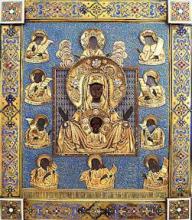 In the 13th century, during the dreadful period of the Tartar invasion of Russia, the devastated province of Kursk was emptied of people and its principal city, Kursk, became a wilderness. Now, the residents of the city of Rylsk, which had been preserved from invasion, often journeyed to the site of Kursk to hunt wild beasts. One of the hunters, going along the bank of the river to Skal, which was not very far from ruined Kursk, noticed an icon lying face down on the ground next to the root of a tree. The hunter picked it up and found that it was an icon of the Sign, such as was enshrined and venerated in the city of Novgorod. At this time, the icon's first miracle was worked, for no sooner had the hunter picked up the sacred image than there immediately gushed forth with great force an abundant spring of pure water. This took place on September 8th in the year 1295.
In the 13th century, during the dreadful period of the Tartar invasion of Russia, the devastated province of Kursk was emptied of people and its principal city, Kursk, became a wilderness. Now, the residents of the city of Rylsk, which had been preserved from invasion, often journeyed to the site of Kursk to hunt wild beasts. One of the hunters, going along the bank of the river to Skal, which was not very far from ruined Kursk, noticed an icon lying face down on the ground next to the root of a tree. The hunter picked it up and found that it was an icon of the Sign, such as was enshrined and venerated in the city of Novgorod. At this time, the icon's first miracle was worked, for no sooner had the hunter picked up the sacred image than there immediately gushed forth with great force an abundant spring of pure water. This took place on September 8th in the year 1295.
The hunter constructed a small wooden chapel and placed the newly manifested image of the Mother of God therein. The residents of Rylsk began to visit the place of the manifestation of this holy object and the icon was glorified by miracles all the more. Prince Vasily Shemyaka of Rylsk ordered that the icon be brought to the city of Rylsk itself and this was done in a solemn manner, for the people of the city went forth to meet the icon of the Mother of God; but Shemyaka himself declined to attend the festivities and for this reason was punished with blindness. The prince, however, repented and straightway re ceived healing. Moved by this miracle, Shemyaka constructed a church in the city of Rylsk in honor of the Nativity of the All-holy Theotokos, and there the miraculous icon was enshrined on September 8th, the day of its manifestation, appointed as the annual feast date.
But the icon vanished in a miraculous manner and returned to the place of its original appearance. The residents of Rylsk continually brought it back, but each time it returned to its former place. Then, understanding that the Mother of God was well pleased to dwell in the place of the manifestation ofher image, they eventually left it there in peace. Innumerable pilgrimages streamed to the site and services of supplication were celebrated there by a certain priest whose name was Bogoliub and who dwelt at the site of the wooden chapel and struggled there in asceticism.
In the year 1383, the province of Kursk was subjected to a new invasion of Tartars. They decided to set fire to the chapel, but it refused to burn, even though they piled up fuel all around it, and so the superstitious barbarians fell upon the priest Bogoliub, accusing him of sorcery. The pious priest denounced their foolishness and pointed out the icon of the NI other of God to them. The malicious Tartars laid hold of the holy icon and cut it in two, casting the pieces to either side. The chapel then caught fire and the priest Bogoliub was carried off a prisoner.
In his captivity, the God-loving elder kept the Faith, placing his hope on the all-holy Mother of God, and this hope did not fail him. Now, one day as he was guarding flocks and passing the time by singing prayers and doxologies in honor of the Mother of God, there passed by some emissaries of the Tsar of Moscow.
They heard this chanting, arranged to ransom the priest from captivity, and Bogoliub returned to the former site of the chapel. There he found the pieces of the miraculous icon which the Tartars had cast away. He picked them up and straightway they grew together, although the signs of the split remained. Learning of this miracle, the residents of Rylsk gave glory to God and to His all-pure Mother. Again they attempted to transfer the holy icon to their city, but once more the miraculous image returned to its former place. A new chapel was then built on the original site of the icon's appearance and here it remained for about 200 years.
The city of Kursk was revived in the year 1597 at the command of Theodore Ivanovich of Moscow. This pious Tsar, who had heard of the miracles of the icon, expressed his desire to behold it, and in Moscow, the icon was greeted with great solemnity. The Tsaritsa, Irene Theodorovna, adorned the holy icon with a precious riza. At the command of the Tsar, the icon was set in a silver-gilt frame upon which were depicted the Lord of Hosts and prophets holding scrolls in their hands. The icon was subsequently returned and, with the close cooperation of the Tsar, a monastery was founded on the site of the chapel. A church, dedicated to the Life-bearing Spring, was built above the same spring that had appeared when the icon was first revealed and the monastery attached to it was called the Kursk Root Hermitage in honor of the manifestation of the icon at the root of the tree.
During an invasion of Crimean Tartars, the icon was transferred to the cathedral church of Kursk, and an exact copy was left at the Hermitage. Tsar Boris Godunov bestowed many precious gifts for the adornment of the icon and even the pretender, the false Dimitry, who desired to call attention to himself and to win the support of those who lived in the vicinity of Kursk, venerated this icon and placed it in the royal mansions where it remained until the year 1615.
While the icon was absent from the city of Kursk, the grace-bearing aid of the Mother of God did not forsake that city, for when in the year 1612 the Poles laid siege to Kursk, certain of the citizens beheld the Mother of God and two radiant monks above the city. Captured Poles related that they, too, had beheld a woman and two radiant men on the city walls, and that this woman made threatening gestures at those who were conducting the siege. The citizens then made a vow to construct a monastery in honor of the all-holy Theotokos and to place the miraculous icon therein. The besiegers were quickly put to flight and in gratitude to their heavenly helper, the people of Kursk built a monastery in honor of the all-holy Theotokos of the Sign.
In 1676, the icon of the Mother of God of the Sign was borne to the Don River to bless the forces of the Don Cossacks. In 1684, a copy of the miraculous icon of the all-holy Theotokos of the Sign was sent to the Monastery of the Root by the sovereigns and great princes Ivan and Peter Alexievich. This copy was set in a silver-gilt frame and a command was made that this copy be borne wherever Orthodox warriors went into battle.
In the year 1812, the Kursk Civic Society sent to General Kutuzov a copy of the miraculous icon of Kursk, setting it in a silver-gilt frame. The commander expressed his gratitude to the citizens of Kursk and his belief that Kursk would remain free, thanks to the protection of the Queen of Heaven.
In March of 1898 a group of anarchists, desiring to undermine the faith ofthe people in the wonder-working power of the icon, decided to destroy it. They placed a time bomb in the Cathedral of the Sign, and at two o'clock in the morning a horrendous explosion rent the air and all the walls of the monastery were shaken. The frightened monastic brethren rushed immediately to the cathedral, where they beheld a scene of horrible devastation. The force of the blast had shattered the gilded canopy above the icon. The heavy marble base, constructed of several massive steps, had been jolted out of position and split into several pieces. A huge metal candlestick which stood before the icon had been blown to the opposite side of the cathedral. A door of cast iron located near the icon n'ad been torn from its hinges and cast outside, where it smashed against a wall and caused a deep crack. All the windows in the cathedral and even those in the dome above were shattered. Amid the general devastation, the holy icon remained intact and even the glass within the frame remained whole. Thinking to destroy the icon, the anarchists had, on the contrary, become the cause of its greater glorification.
Every year on Friday of the ninth week after Pascha, the icon of the Sign was solemnly borne in procession from the Kursk Cathedral of the Sign to the place of its original manifestation at the Kursk Hermitage, where it remained until September 12. On September 13, it was again solemnly returned to the city of Kursk. This procession was instituted in the year 1618 in memory of the transfer of the icon from Moscow to Kursk and to commemorate its original appearance.
During the Bolshevik revolution, the icon was removed from the Cathedral of the Sign on April 12, 1918. Search was made for the icon hut without result. The holy object was discovered under the following circumstances: Not far from the monastery there lived a poor girl and her mother who for three days had not had anything to eat. At that time Kursk was controlled by the Bolshevik regime. On May 3, the girl, a seamstress, went off to the marketplace in search of bread. Returning home at about one o'clock in the morning, she passed by a well which, according to tradition, had been dug by St. Theodosius of the Caves. There, on the edge of the well, she beheld a package wrapped in a sack, and when she opened it, in the package she found the sacred icon, which apparently had been left there by those who had stolen it.
At the end of October 1919, when the White Russian Army was evacuating the city of Kursk, twelve monks of the monastery transferred the icon to the city of Belgorod, from which it was again transferred, first to Taganrog and Ekateri nodar, and then to Novorossiisk. During the cvacuation, with the permission of Metropolitan Anthony Khrapovitsky who was then President of the Higher Ecclesiastical Administration in Southern Russia, the icon was taken aboard the steamship St. Nicholas by Bishop Theophan of Kursk on March 1, 1920, and was transported to the city of Thessalonica. On April 3, Bishop Theophan took the icon to the city of Pec, the ancient capital of Serbia. For four months the icon remained in Pec, and in September, at the request of Baron Wrangel, it was returned again to the Crimea. A year after departing from the city of Kursk, on October 29, 1920, the holy image again left its native land during the evacuation of the White Army and those Russian people who refused to submit to the Soviet regime. After arriving again in the Kingdom of the Serbs, Croatians and Slovenes, with the blessing of Patriarch Dimitry. the holy icon remained with Bishop Theophan in the Serbian monastery of Yazak on Frushkaya Mountain. From the end of 1927, the icon was to be found in the Russian church of the Holy Trinity in the city of Belgrade.
With the blessing of the Synod of Bishops, Bishop Theophan bore the icon around to various places where Russians of the diaspora dwelt. During World War II, when Belgrade was subjected to bombardment and other tribulations associated with the war, the miraculous icon became a rampart of hope for all that approached it with sincere prayer.
The steadfast companion of those Russian people who did not accept the satanic authority, this great and ancient holy object, which remained in Moscow during the dreadful turmoil of the 17th century, was removed from Yugoslavia in the autumn of 1944 together with those who again fled the godless regime. From ruined Vienna, the icon was borne to the tranquil city of Carlsbad to which the Synod of Bishops had been evacuated. With the approach of the Bolsheviks it was again transferred to Munich in the spring of 1945. The holy icon proved to be an unending consolation to many thousands of people who were experiencing all the trials and tribulations of the latter years of World War II. From Munich the icon was borne to Switzerland, France, Belgium, England, Austria, and many cities and camps in Germany itself. Subsequently, the icon was transferred to the New World where it had its permanent residence first in the New Kursk Hermitage in Mahopac, N.Y., and then in the Synod's Cathedral Church of the Mother of God of the Sign in New York City, the residence of the First Hierarch of the Russian Church Abroad. At present, by decree of the Council of Bishops of the Russian Orthodox Church Abroad, a festival is held in honor of the icon at the New Kursk Hermitage in Mahopac, N.Y., on the Sunday nearest the feast of the Nativity of the Most Holy Theotokos, and in the Synod's Cathedral of the Mother of God of the Sign in New York City on November 27/December 10.
Troparion. Tone 4.
Having obtained thee as an unassailable wall and as a fountain of miracles, 0 most pure Theotokos, thy servants subdue the attacks of enemies. Wherefore, we pray to thee: Grant peace to our native land, and to our souls great mercy.
Kontakion. Tone 8.
We thy people celebrate thy venerable Icon of the Sign, 0 Mother of God, whereby thou didst grant thy city a wonderful victory against its enemies. Wherefore we cry unto thee with faith: Rejoice, 0 Virgin, thou boast of Christians.
Akathist to the Most Holy Theotokos (Церковно-славянский | Русский)
"Of the Sign" Novgorod Icon
27 November / 10 December
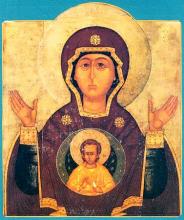 The icon of the Mother of God which is known as the "Sign" depicts the Most Holy Theotokos seated, with her hands raised in prayer. Depicted upon a round shield or sphere, upon her breast, is the Divine Infant - the Saviour-Emmanuel - in an attitude of blessing. Such a representation is of a type manifested in the very earliest iconographic depictions of the Theotokos. In the tomb of Saint Agnia in Rome, the Theotokos is depicted with arms extended in prayer, and with the Infant seated on her knees.
The icon of the Mother of God which is known as the "Sign" depicts the Most Holy Theotokos seated, with her hands raised in prayer. Depicted upon a round shield or sphere, upon her breast, is the Divine Infant - the Saviour-Emmanuel - in an attitude of blessing. Such a representation is of a type manifested in the very earliest iconographic depictions of the Theotokos. In the tomb of Saint Agnia in Rome, the Theotokos is depicted with arms extended in prayer, and with the Infant seated on her knees.
This image dates to the fourth century. Moreover, there is a well known sixth century icon of the Theotokos, known as the "Nikopeia" icon, in which the Most Holy Theotokos is depicted, seated on a throne, and holding before her in both hands an oval shield bearing the image of the Saviour-Emmanuel. Icons of the Mother of God known by the name of the "Sign" appeared in Russia during the eleventh and twelfth centuries, and took on that name after the miraculous sign given by the Novgorod icon in the year 1170.
In that year, the combined forces of landed princes under the direction of the son of Andrei Bogoliubov, prince of Suzdal, approached the walls of Great Novgorod. The people of Novgorod were left nowhere to turn for help but to God. Day and night they prayed, asking the Lord not to abandon them. On the third night, Ilya [Elias], Archbishop of Novgorod, heard a lovely voice directing him to take from the Church of our Lord's Transfiguration, on Ilya Street, the image of the Most Holy Theotokos, and to carry it out to the city wall. As they were carrying the icon, the enemy loosed upon the procession a cloud of arrows, one of which struck the face of the Theotokos written upon the icon. From her eyes tears began to flow, and her icon turned to face the city. Immediately after the appearance of such a divine sign, the attackers were struck with an inexplicable terror, and began to strike down one another. The people of Novgorod, emboldened by God, fearlessly entered the fray, and were victorious.
In memory of the miraculous intercession of the Queen of Heaven, Archbishop Ilya immediately directed the establishing of a feast day in honor of the Sign of the Mother of God, a feast day which the entire Russian Church continues to annually celebrate to this day. The Athonite monk Pachomius Logothetos, who was present at the celebration of the icon in Russia, composed two canons for this feast. On some Novgorod icons are depicted, in addition to the Theotokos and the Pre-eternal Infant, the miraculous events of 1170. The miraculous icon remained for 186 years in the Church of our Lord's Transfiguration on Ilya Street. In the year 1356, a church in honor of the Sign of the Most Holy Theotokos was built for the icon in Novgorod, and became the Cathedral Church of the Monastery of the Sign.
Many copies of the "Sign" Icon are known throughout Russia. Many of them shone forth with miracles in their local churches and became known by the names of those places in which the miracles occurred. Among such copes are the Dionysius-Glushitsk, Abalatsk, Kursk, Seraphim-Ponetaevsk Icons and others Icons of the Sign.
"Of the Sign" - "Of Seraphimo-Ponetaev" Icon
27 November / 10 December
 Икона эта написана в 1879 году Клавдией Войлошниковой, одной из сестер Серафимо-Понетаевского монастыря Нижегородской епархии Арзамасского уезда. В 1885 году 14 мая некоторыми из сестер замечено было на лике Богоматери какое-то особенное просветление. Многие больные устремились к ней с молитвою веры и получили исцеление. Икона стояла в письмоводительской келье; но на другой день после этого чудесного явления была перенесена в церковь, куда стал собираться народ для поклонения св. иконе. По распоряжению начальства, назначено было следствие, и тогда многими чудесными исцелениями больных подтвердилась благодатная сила иконы. По предписанию Св. Синода икона, находившаяся все время следствия в соборе, была возвращена в Серафимо-Понетаевский монастырь.
Икона эта написана в 1879 году Клавдией Войлошниковой, одной из сестер Серафимо-Понетаевского монастыря Нижегородской епархии Арзамасского уезда. В 1885 году 14 мая некоторыми из сестер замечено было на лике Богоматери какое-то особенное просветление. Многие больные устремились к ней с молитвою веры и получили исцеление. Икона стояла в письмоводительской келье; но на другой день после этого чудесного явления была перенесена в церковь, куда стал собираться народ для поклонения св. иконе. По распоряжению начальства, назначено было следствие, и тогда многими чудесными исцелениями больных подтвердилась благодатная сила иконы. По предписанию Св. Синода икона, находившаяся все время следствия в соборе, была возвращена в Серафимо-Понетаевский монастырь.
"Of the Sign" Pavlovsk Icon
27 November / 10 December
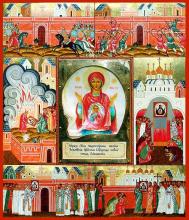 In the Holy Transfiguration Cathedral in Pavlosk, Voronezh District, there is a grace-filled “Sign” Icon of the Mother of God. In 1696, Emperor Peter I besieged and decimated the city of Azov. Two icons were found in the ruins: an icon of St. John the Baptist, and the “Sign” Icon of the Mother of God, which Tsar Peter immediately installed in the Azov Cathedral. When, in 1711, Azov was returned to the Turks, Peter I directed that the Sign Icon be transferred to the Cathedral of the Oserdsky Fortress, which at the same time was renamed the town of Pavlovsk. The clergy of the Azov fortress were also transferred to that Cathedral, along with the liturgical utensils.
In the Holy Transfiguration Cathedral in Pavlosk, Voronezh District, there is a grace-filled “Sign” Icon of the Mother of God. In 1696, Emperor Peter I besieged and decimated the city of Azov. Two icons were found in the ruins: an icon of St. John the Baptist, and the “Sign” Icon of the Mother of God, which Tsar Peter immediately installed in the Azov Cathedral. When, in 1711, Azov was returned to the Turks, Peter I directed that the Sign Icon be transferred to the Cathedral of the Oserdsky Fortress, which at the same time was renamed the town of Pavlovsk. The clergy of the Azov fortress were also transferred to that Cathedral, along with the liturgical utensils.
In the 1820s, the Icon was installed in a large gilded, starburst-shaped frame, suspended over the Royal Doors. After services, this revered Holy Icon would be lowered to afford the faithful an opportunity to venerate it. Toward the conclusion of the Vigil, when the priest would stand before the Royal Doors for the dismissal of the First Hour, clergy would come from the choirs and, flanking the priest, would sing, “No one coming to thee will be disgraced.” At that point, the Holy Icon would be quietly lowered by a cord from which it was suspended. As the lower rays of the starburst touched the floor, the singing would conclude with “Most-holy Theotokos, save us!” and first the clergy and altar servers, and then the people, would venerate the Holy Icon.
The miraculous Sign Icon would be brought into private homes for prayer services. Each year on the 9th Friday after Pascha, it would be taken in a Procession of the Cross to “the cold well,” over six kilometers from Pavlovsk. At the well, there would be a prayer service to the Mother of God, and then a Panikhida for Emperor Peter I, who founded the city of Pavlovsk, and donated the Holy Icon to the Pavlovsk Cathedral.
"Sign" ("Korchemnaya" or "Tavern")
27 November / 10 December
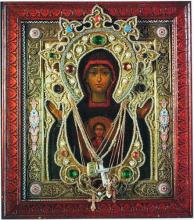 This “Sign” Icon of the Most-holy Theotokos got the added name “Korchemnaya” or “Tavern” Icon, after a certain widow of Ryazan who suffered from a weakness for wine, pawned her house icon of “Our Lady of the Sign.” Th God-fearing tavern keeper who took the icon from the widow as a pledge installed it on his icon shelf. In the morning, the widow sobered up, was horrified at what she had done, got some money, and redeemed the icon. However, the next day the icon disappeared from the widow’s house. To his amazement, the tavern keeper saw the icon reappear on his icon shelf. To everyone’s surprise, the repentant widow immediately stopped drinking. The icon remained at the tavern and received its unusual name. By prayers before the Korchemnaya Icon, the Mother of God has often rendered help to many people who appeal to her.
This “Sign” Icon of the Most-holy Theotokos got the added name “Korchemnaya” or “Tavern” Icon, after a certain widow of Ryazan who suffered from a weakness for wine, pawned her house icon of “Our Lady of the Sign.” Th God-fearing tavern keeper who took the icon from the widow as a pledge installed it on his icon shelf. In the morning, the widow sobered up, was horrified at what she had done, got some money, and redeemed the icon. However, the next day the icon disappeared from the widow’s house. To his amazement, the tavern keeper saw the icon reappear on his icon shelf. To everyone’s surprise, the repentant widow immediately stopped drinking. The icon remained at the tavern and received its unusual name. By prayers before the Korchemnaya Icon, the Mother of God has often rendered help to many people who appeal to her.
In 1850, after the tavern stopped doing busines, the icon was given to the church of St. Symeon the Stylite. There it remained until the church was closed down during the Soviet era. Thereafter, the miraculous “Sign” “Tavern” Icon of the mother of God was in the care of a certain pious family in Ryazan. Today it is in the Monastery of St. John the Theologian, Ryazan Diocese. There is a copy of the miraculous icon in Ryazan’s Nikolo-Yamsky church, a metochion of the monastery.
"Unexpected Joy"
9/22 December
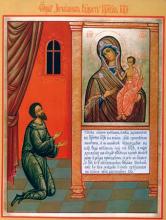 The history of this icon is related by the Holy Hierarch Dimitry of Rostov in his work, "The Bedewed Fleece". There was a man who despite living his life in sins nonetheless had pious love and devotion to the Mother of God.
The history of this icon is related by the Holy Hierarch Dimitry of Rostov in his work, "The Bedewed Fleece". There was a man who despite living his life in sins nonetheless had pious love and devotion to the Mother of God.
Without fail, he daily prayed before her icon, saying those words once spoken by the Archangel Gabriel: "Rejoice, thou who art full of grace!"
It came to pass that as he was about to go off to engage in some sinful activity, he turned to pray before the icon of the Mother of God. Immediately he began to tremble, as he saw the image of the Mother of God appear to move. The wounds on the hands, feet and side of the Divine Infant opened up, and from them burst forth blood. Falling to the ground, the transgressor shouted: "O Lady, who has done this?"
The Mother of God answered: "You and other sinners once again, like the Jews, are crucifying my Son. You call me merciful. But then why do you insult me with your lawless acts? "O Mistress", answered the sinner, "may my sins not overcome your inexpressible goodness! You are the only hope of all sinners. Entreat your Son and our God on my behalf."
Our Mistress twice repeated her prayer to the Infant Christ, but He remained adamant, until finally he responded to the persis-tent entreaties of the Mother of God: "I will fulfill your request. May your wish be granted. Because of you, this person’s sins are remitted. Let him, in token of forgiveness, kiss My wounds."
And lo, the forgiven sinner, before whom the inexhaustible mercy of the Mother of God was manifest in such a wonderful man-ner, raised himself up from the ground, and with inexpressible joy kissed the wounds of his Saviour. From that moment, he lived a clean and pious life. This event provided the faithful with the incentive to write the "Unexpected Joy" icon of the Mother of God.
On this icon is depicted a man, on his knees, praying before the image of the Mother of God. Below the image are usually written the opening words of the story: "There was a certain transgressor".
PARISH LIFE
RECENT VIDEOS
Address of our Cathedral
Subscribe to our mailing list
While all the materials on this site are copyrighted, you may use them freely as long as you treat them
with respect and provide attribution on the Russian Orthodox Cathedral of St.John the Baptist of Washington DC.
